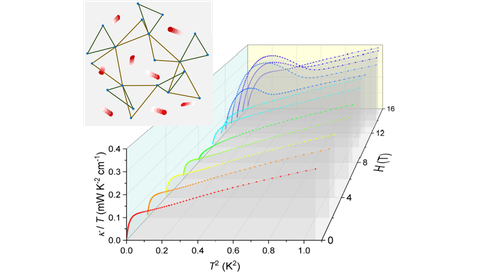Jan 22, 2024
Research: Spinon heat transport in the 3D quantum magnet PbCuTe2O6
The spinon, a charge-neutral fractionalization of the excitations of the electronic spin, is an elusive emergent quasiparticle of some quantum spin liquid (QSL) states. As a fermionic quasiparticle, spinons behave like electrons in many ways. In particular, the detection of a spinon Fermi surface, in conceptual analogy to the electronic Fermi surface, is regarded to be a strong proof for a QSL state. The search for spinons, and the QSL states that accommodate them, is mainly devoted to lower dimensional systems. However, convincing evidences for the existence of spinons and QSL states are not only scarce, but also regarded to be fragile in presence of sample imperfections, probably due to their lower dimensional nature.
In this work, we report thermal transport properties of the three-dimensional QSL candidate PbCuTe2O6 down to the millikelvin temperature range. A clear linear-in temperature contribution to thermal conductivity indicates the existence of a Fermi surface, in this case, the spinon Fermi surface. Such feature is found to prevail across crystals synthesized by different techniques, to be robust against sample disorders, ferroelectric transitions, magnetic fields and induced magnetic phases. The idea of emergent excitations of a disordered ground state forming well-defined objects is reminiscent of the concept of quasiparticles in metals which is known for a century. In tandem with previous reports on evidences of a QSL state in PbCuTe2O6 from other aspects, this material constitutes a model system for investigating true QSL states in more detail.
X. Hong, M. Gillig, A. R. N. Hanna, S. Chillal, A. T. M. N. Islam, B. Lake, B. Büchner, C. Hess,
Spinon Heat Transport in the Three-Dimensional Quantum Magnet PbCuTe2O6,
Phys. Rev. Lett. 131, 256701 (2023) (arXiv)

